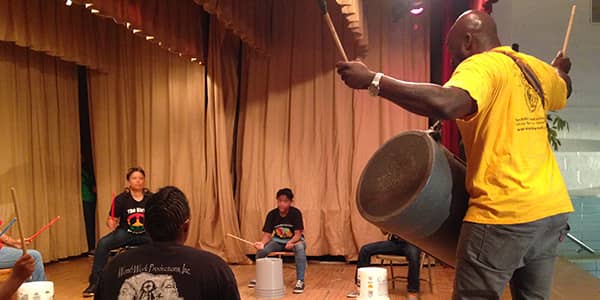Blog

Breaking down barriers with the arts

By Kwame Opare, High Point High School Dance Teacher and Young Audiences teaching artist
I have had the privilege to work with a diverse group of learners in the Prince George’s County school system so far this school year. As a dance teacher for all grades at High Point High School, I have been faced with a challenge not yet experienced throughout my years of bringing my craft to the classroom as a teaching artist. High Point’s population is largely immigrant and first-generation American young people and English is often not the first language (or even second language in some cases) for many of my students. This has compelled me to modify, and even synthesize new instructional methods, to ensure the transfer of knowledge.
What I’ve noticed in this short but meaningful time is that no matter where you are on Earth, young people want to learn, they crave information. They will test you as the adult to see if you really care whether or not they get it, or if they even show up. I care, and in this short time, I believe that I have convinced my students of this. Now that I “got ’em,” the onus is on me to make sure they know that they have the right to learn and that they must take the process of learning into their own hands. Creating an environment where students feel confident and enabled to take ownership of their learning is essential to their growth as students and beyond. We as educators must only provide a framework of knowledge and wisdom that comes from study and experience in a safe environment so that the true capacity for brilliance can be nurtured in our young people.
What do the arts have to do with all of this? After all, it’s just dance. Through dance, I have seen the strengths and weaknesses of my students and have used them both to fortify my instructional methods. The brilliance of all my students is evident, but is often locked away beneath external and internal distractions, such as self-doubt, embarrassment, worries about what peers will think, or problems at home. Through dance, we can successfully weed through these distractions. Some of my students at High Point tell me their stories and in response I just ask them to please keep coming to class because they are a part of something now. Their growth from the first day of class to today has been a joy to observe and I feel so fortunate to bear witness.

At first they came in scared, terrified, some not knowing the English language, and nearly none of them knowing the language of dance. Though the proficiency levels vary, the feelings of frustration from the challenge is shared. Yet, we are starting to build a community of support and understanding with confident souls that know they CAN! Some of those who stood in the back of the class at first are finding their way to the front and are becoming leaders, helping others and welcoming newcomers.
In dance, the process often begins with what I refer to as the ugly duckling syndrome. “Feeling ‘stupid’ and looking ‘stupid’ is OK,” I tell my students. I remind them that we all looked “stupid” when we were learning to walk as babies but the alternative was to never run and we wouldn’t have that! The process is what makes art making so fulfilling and ultimately what makes a teaching artist so effective. Artists know and respect the strength of the process because we are immersed in it daily. Effectively bringing the idea of process into the classroom has a positive and lasting impact on students.
It is through these processes that students are engaged where they may otherwise be distracted or lack interest. The process instills in young people the ability to effectively gather resources, question, problem-solve, and persevere to see something through to the end, whatever challenges they may face in academy and beyond.








